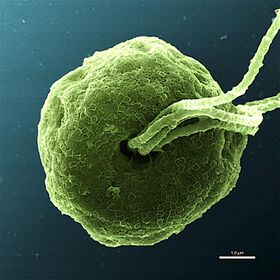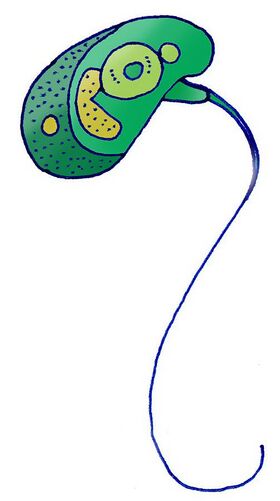Biology:Prasinophyte
| Biology:Prasinophyte Paraphyletic group of chlorophytes
| |
|---|---|

| |
| Pyramimonas sp. | |
| Scientific classification | |
| (unranked): | Viridiplantae |
| Division: | Chlorophyta |
| Informal group: | Prasinophyte |
| Included classes[1][2] | |
| Excluded classes (i.e. chlorophytes not considered prasinophytes) | |
The prasinophytes are a group of unicellular green algae.[3] Prasinophytes mainly include marine planktonic species, as well as some freshwater representatives.[3][4] The prasinophytes are morphologically diverse, including flagellates with one to eight flagella and non-motile (coccoid) unicells. The cells of many species are covered with organic body scales; others are naked.[4] Well studied genera include Ostreococcus, considered to be the smallest (ca. 0.95 μm) free-living eukaryote,[5] and Micromonas, both of which are found in marine waters worldwide. Prasinophytes have simple cellular structures, containing a single chloroplast and a single mitochondrion. The genomes are relatively small compared to other eukaryotes (about 12 Mbp for Ostreococcus[6][7] and 21 Mbp for Micromonas[8]). At least one species, the Antarctic form Pyramimonas gelidicola, is capable of phagocytosis and is therefore a mixotrophic algae.[9]
Some authors treat the prasinophytes as a polyphyletic grouping of green algae from different clades. As the Tetraphytina emerged in the Prasinophytes, recently authors include it, rendering it monophyletic, and equivalent to chlorophyta.[10][11]
Ecology
A study of photosynthetic gene-sequence diversity (rbcL) in the Gulf of Mexico indicated that Prasinophytes are particularly prevalent at the Subsurface Chlorophyll Maximum (SCM)[12] and several different ecotypes of Ostreococcus have been detected in the environment.[13] These ecotypes were thought to be distinguished in the environment by their adaptation to light intensities. O. lucimarinus was isolated from a high-light environment[14] and observed year-round in the coastal North Pacific Ocean.[15] RCC141 was considered low-light, because it was isolated from the lower euphotic zone. These strains, or ecotypes, were later shown to live in different habitats (open-ocean or mesotrophic) and their distributions do not appear to be connected to light availability.[16] O. tauri was isolated from a coastal lagoon and appears to be light-polyvalent. Genetic data indicates that distinct molecular differences exist between the different ecotypes that have been detected.[17]
Prasinophytes are subject to infection by large double-stranded DNA viruses belonging to the genus Prasinovirus in the family Phycodnaviridae,[18][19][20] as well as a Reovirus.[21] It has been estimated that from 2 to 10% of the Micromonas pusilla population is lysed per day by viruses.[22]
Phylogeny
Recent studies agree that the prasinophytes are not a natural group, being highly paraphyletic.[4][23][24][25] Relationships among the groups making up the Chlorophyta are not fully resolved. The cladogram produced by Leliaert et al. 2011[4] and some modification according to Silar 2016,[26] Leliaert 2016[27] and Lopes dos Santos et al. 2017[1] is shown below. The blue shaded groups are or have traditionally been placed in the Prasinophyceae[3]). The species Mesostigma viride has been shown to be a member of the Streptophyta or basal Green algae. The others are member of the Chlorophyta.
| Green Algae |
| ||||||||||||||||||||||||||||||||||||||||||||||||||||||||||||||||||||||||||||||||||||||||||||||||||||||||||||||||||||||||
As 2020 paper places the Palmophyllophyceae (prasinophyte clade VI) in a new phylum outside of the Chlorophyta and Streptophyta, the Prasinodermophyta.[28]
See also
- Smallest organisms
References
- ↑ 1.0 1.1 "Chloropicophyceae, a new class of picophytoplanktonic prasinophytes". Scientific Reports 7 (1): 14019. October 2017. doi:10.1038/s41598-017-12412-5. PMID 29070840. Bibcode: 2017NatSR...714019L.
- ↑ Linzhou Li; Sibo Wang; Hongli Wang; Sunil Kumar Sahu; Birger Marin; Haoyuan Li; Yan Xu; Hongping Liang et al. (22 June 2020). "The genome of Prasinoderma coloniale unveils the existence of a third phylum within green plants". Nature Ecology & Evolution 4 (9): 1220–1231. doi:10.1038/s41559-020-1221-7. PMID 32572216.
- ↑ 3.0 3.1 3.2 Sym, S. D. and Pienaar, R. N. 1993. The class Prasinophyceae. In Round, F. E. and Chapman, D. J. (eds) Progress in Phycological Research, Vol. 9. Biopress Ltd., Bristol, pp. 281-376.
- ↑ 4.0 4.1 4.2 4.3 "Into the deep: new discoveries at the base of the green plant phylogeny". BioEssays 33 (9): 683–92. September 2011. doi:10.1002/bies.201100035. PMID 21744372.
- ↑ "Smallest eukaryotic organism". Nature 370 (6487): 255. 1994. doi:10.1038/370255a0. Bibcode: 1994Natur.370..255C.
- ↑ "Genome analysis of the smallest free-living eukaryote Ostreococcus tauri unveils many unique features". Proceedings of the National Academy of Sciences of the United States of America 103 (31): 11647–52. August 2006. doi:10.1073/pnas.0604795103. PMID 16868079. Bibcode: 2006PNAS..10311647D.
- ↑ "The tiny eukaryote Ostreococcus provides genomic insights into the paradox of plankton speciation". Proceedings of the National Academy of Sciences of the United States of America 104 (18): 7705–10. May 2007. doi:10.1073/pnas.0611046104. PMID 17460045. Bibcode: 2007PNAS..104.7705P.
- ↑ "Green evolution and dynamic adaptations revealed by genomes of the marine picoeukaryotes Micromonas". Science 324 (5924): 268–72. April 2009. doi:10.1126/science.1167222. PMID 19359590. Bibcode: 2009Sci...324..268W.
- ↑ Mixotrophy in the Antarctic phytoflagellate, Pyramimonas gelidicola (Chlorophyta: Prasinophyceae)
- ↑ "Evolution of DDB1-binding WD40 (DWD) in the viridiplantae". PLOS ONE 13 (1): e0190282. 2018-01-02. doi:10.1371/journal.pone.0190282. PMID 29293590. Bibcode: 2018PLoSO..1390282T.
- ↑ "The phycocyanobilin chromophore of streptophyte algal phytochromes is synthesized by HY2". The New Phytologist 214 (3): 1145–1157. May 2017. doi:10.1111/nph.14422. PMID 28106912.
- ↑ "Vertical Structure of the Phytoplankton Community Associated with a Coastal Plume in the Gulf of Mexico". Marine Ecology Progress Series 251: 87–101. 2003. doi:10.3354/meps251087. Bibcode: 2003MEPS..251...87W.
- ↑ "Diversity of picoplanktonic prasinophytes assessed by direct nuclear SSU rDNA sequencing of environmental samples and novel isolates retrieved from oceanic and coastal marine ecosystems". Protist 155 (2): 193–214. June 2004. doi:10.1078/143446104774199592. PMID 15305796.
- ↑ "Assessing the dynamics and ecology of marine picophytoplankton: The importance of the eukaryotic component". Limnology and Oceanography 49 (1): 168–179. 2004. doi:10.4319/lo.2004.49.1.0168. Bibcode: 2004LimOc..49..168W.
- ↑ "Picoeukaryote diversity in coastal waters of the Pacific Ocean". Aquatic Microbial Ecology 43 (2): 165–175. 2006. doi:10.3354/ame043165. http://oceanrep.geomar.de/46057/1/Picoeukaryote-diversity-in-coastal-waters-of-the-Pacific-OceanAquatic-Microbial-Ecology.pdf.
- ↑ "Global distribution patterns of distinct clades of the photosynthetic picoeukaryote Ostreococcus". The ISME Journal 5 (7): 1095–107. July 2011. doi:10.1038/ismej.2010.209. PMID 21289652.
- ↑ "Ecotype diversity in the marine picoeukaryote Ostreococcus (Chlorophyta, Prasinophyceae)". Environmental Microbiology 7 (6): 853–9. June 2005. doi:10.1111/j.1462-2920.2005.00758.x. PMID 15892704.
- ↑ "A virus which lyses the marine nanoflagellate, "Micromonas pusilla"". Nature 281 (5729): 299–301. 1979. doi:10.1038/281299a0. Bibcode: 1979Natur.281..299M.
- ↑ Cottrell, Matthew T.; Suttle, Curtis A. (1991). "Wide-spread occurrence and clonal variation in viruses which cause lysis of a cosmopolitan, eukaryotic marine phytoplankter, "Micromonas pusilla"". Marine Ecology Progress Series 78: 1–9. doi:10.3354/meps078001. Bibcode: 1991MEPS...78....1C.
- ↑ "Abundance, spatial distribution and genetic diversity of Ostreococcus tauri viruses in two different environments". Environmental Microbiology Reports 2 (2): 313–21. April 2010. doi:10.1111/j.1758-2229.2010.00138.x. PMID 23766083.
- ↑ "Micromonas pusilla reovirus: a new member of the family Reoviridae assigned to a novel proposed genus (Mimoreovirus)". The Journal of General Virology 87 (Pt 5): 1375–83. May 2006. doi:10.1099/vir.0.81584-0. PMID 16603541.
- ↑ Cottrell, Matthew T.; Suttle, Curtis A. (1995-06-01). "Dynamics of lytic virus infecting the photosynthetic marine picoflagellate "Micromonas pusilla"". Limnology and Oceanography 40 (4): 730–739. doi:10.4319/lo.1995.40.4.0730. ISSN 1939-5590. Bibcode: 1995LimOc..40..730C.
- ↑ "Green algae and the origin of land plants". American Journal of Botany 91 (10): 1535–56. October 2004. doi:10.3732/ajb.91.10.1535. PMID 21652308.
- ↑ "Streptophyte algae and the origin of embryophytes". Annals of Botany 103 (7): 999–1004. May 2009. doi:10.1093/aob/mcp044. PMID 19273476.
- ↑ "Nested in the Chlorellales or independent class? Phylogeny and classification of the Pedinophyceae (Viridiplantae) revealed by molecular phylogenetic analyses of complete nuclear and plastid-encoded rRNA operons". Protist 163 (5): 778–805. September 2012. doi:10.1016/j.protis.2011.11.004. PMID 22192529.
- ↑ Silar, Philippe (2016), "Protistes Eucaryotes: Origine, Evolution et Biologie des Microbes Eucaryotes", HAL Archives-ouvertes: 1–462, https://hal.archives-ouvertes.fr/hal-01263138
- ↑ "Chloroplast phylogenomic analyses reveal the deepest-branching lineage of the Chlorophyta, Palmophyllophyceae class. nov". Scientific Reports 6 (1): 25367. May 2016. doi:10.1038/srep25367. PMID 27157793. Bibcode: 2016NatSR...625367L.
- ↑ Linzhou Li; Sibo Wang; Hongli Wang; Sunil Kumar Sahu; Birger Marin; Haoyuan Li; Yan Xu; Hongping Liang et al. (22 June 2020). "The genome of Prasinoderma coloniale unveils the existence of a third phylum within green plants". Nature Ecology & Evolution 4 (9): 1220–1231. doi:10.1038/s41559-020-1221-7. PMID 32572216.
External links
| Wikimedia Commons has media related to Prasinophyceae. |
Wikidata ☰ Q134915 entry
 |



